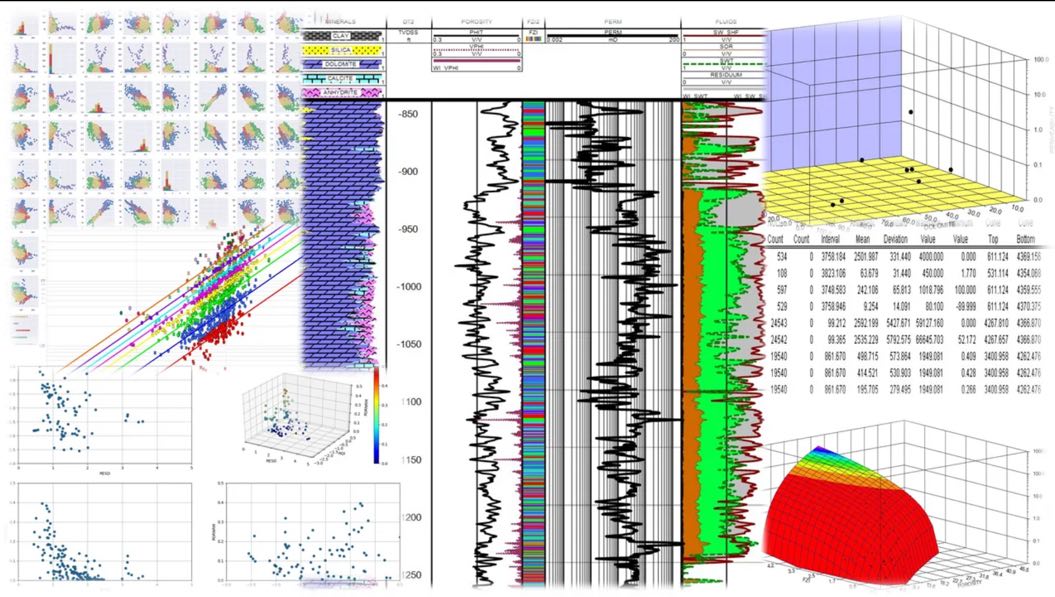Petrophysical Analysis Services
The Wallace International (WI) Petrophysical Evaluation Team consists of highly experienced petrophysicists and technicians that deliver cost-effective, timely petrophysical solutions. Our petrophysics staff has over 100 years of combined working experience with major international oil companies where the integration of data and multi-disciplinary asset-teams were the rule and not the exception.
Integrated Petrophysical Evaluations
 Our Technologists bring to the table the knowledge, skills, and ability to do the job right the first time. We will listen, understand and address your needs, any day, at any time.
Our Technologists bring to the table the knowledge, skills, and ability to do the job right the first time. We will listen, understand and address your needs, any day, at any time.
Wallace International, LLC offers a complete suite of petrophysical analysis services for both Exploration and Production upstream activities. Our methodology for petrophysics includes the integration of all available well data to meet the specific technical and business needs of our clients. From estimating physical rock properties using core data with wireline logs to the more complex probabilistic lithology modeling and saturation-height function analysis, WI will meet any challenge.
Wallace International, LLC has at its disposal best-in-class petrophysical analysis software and computing technology. Our core petrophysical applications run on a network PC platform using Microsoft Windows 7 and 10 as our preferred operating system. Wallace International, LLC utilizes CGG’s POWERLOG 10+ petrophysical software for all of our petrophysical projects. Our Technologists are competent users of RECALL (UNIX) if needed.
Services Offered
Quick-look evaluations
- Drilling wells or just looking for an 80% solution. Expect 8 hours or less turn-around service after receipt of data. Includes estimates of net pay, porosity, water saturation, and a brief summary report.
- Integration of petrophysical data for detailed evaluations
- Includes wireline (open/cased) and MWD log data, routine/special core analysis, DST and production data, formation tester data, mud-logs, lithology logs, gas chromatograph data and deviation surveys.
- Reservoir description projects
- Multi-well evaluations: develop robust petrophysical models to estimate rock and fluid properties for in-place volumetrics, mapping, reservoir simulation, and government submission. Lithology, porosity, fluid saturation and permeability are quantified based on core measurements.
Specialized petrophysical services
- Matrix inversion lithology & porosity modeling utilizing as many log measurements as possible to define/predict the subsurface mineralogy, porosity, and porosity type. The modeling incorporates core data such as X-ray Diffraction (XRD), routine core analysis to calibrate the inversion model. Other data including mud-log description and other data can also be used to improve the model.
- Saturation height function modeling (capillary and bulk volume water-based). This useful technique can be used to predict the fluid saturation anywhere within the reservoir zone through the incorporation of core capillary pressure data, core porosity and permeability measurements and fluid density. Skelt, Cuddy and other J-function height function models are available for use.
- Non-Archie water saturation equation development and implementation. Used in reservoirs where clay and its distribution within the reservoir becomes an issue. Waxman-Smit, Juhasz, and other electrical efficiency resistivity-based models are available.
- Matrix and fluid permeability modeling and implementation. Permeability modeling combines core measurements with log measurements using a variety of models and techniques to improve prediction. Models include: Flow Zone Index modeling, Chiew Choo pore throat model, Kozeny- Carman model, Timur, Tixier, and other viable techniques are available.
- Rock mechanical properties modeling and prediction. Rock elastic properties are invaluable when designing well casing and mud weight programs, hydraulic (fracture) stimulation design and performing formation failure analysis. Wireline compressional and shear interval transit times and bulk density data can be used to calculate elastic properties. The most important elastic properties, Poisson’s ratio, and Young’s modulus can be used to derive a “brittleness” index.
- Fractional flow prediction utilizes core-based relative permeability and fluid saturation measured data with log-derived scaled petrophysical properties. Wallace-International petrophysicists predict/estimate the fractional flow of reservoir fluids (gas/oil/water) using the Buckley-Leverett method. Comparison of produced water cut, cumulative hydrocarbon recoveries are used to compare the estimated results.
- Cluster analysis-Rock facies prediction classifies a log data set into groups that are internally homogeneous and externally isolated on the basis of a measure of similarity or dissimilarity between groupings. Dendrograms and elbow methods are used to determine the optimal number of clusters.
- Flow Zone Analysis (FZI) prediction utilizes cluster analysis and “supervised” neural network techniques along with Dr. Jude Amaefule’s methods to predict flow zones and permeability.
- Unconventional reservoir modeling
- Shale-Gas probabilistic petrophysics modeling that includes: predictions of lithology/mineralogy, porosity and porosity-type, matrix permeability, TOC, TGC and fluid saturation. Most shale plays worked have significant core integration.
- Tight gas sand analysis (For more info download the the Tight Gas Sand PDF )
- Carbonates and highly fractured reservoirs: quantify critical deformation elements that impact the production of faulted and fractured reservoirs. Use probabilistic modeling for petrophysical property assessment.
Petrophysical statistics (summary)
- Net pay, net reservoir summaries: net thickness, Avg. porosity, water saturation, permeability, etc.
- Cutoff sensitivity analysis: quantify hydrocarbon pore volume.


